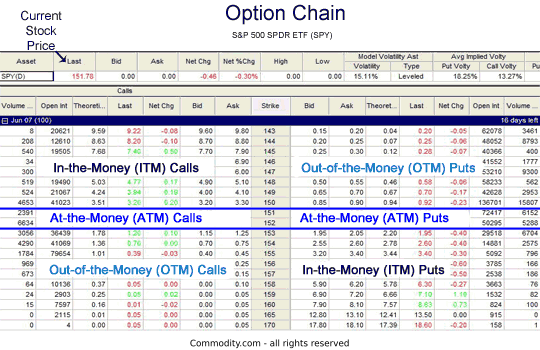This options guide focuses on what ‘at-the-money’ options mean for options traders.
We also cover the difference between intrinsic and extrinsic value, along with when an option has more intrinsic or extrinsic value based on the strike price and stock price.
Contents
Read on to find out more about what ITM, ATM, and OTM mean.
What Does ‘At-The-Money’ Mean?
At-the-money means when an option’s strike price is near where the stock price is.
For example, if the stock of XYZ is trading at $50.15, the $50 strike price for both puts and calls would be considered to be the at-the-money option strike price. An at-the-money option has little to no intrinsic value.

For calls, an option whose strike price is below where the stock price is currently. For example, if the stock of XYZ is trading at $50.34, the $45 strike price would be considered to be an in-the-money call option.
Intrinsic Value & Extrinsic Value
An in-the-money call option is primarily made up of intrinsic value, with very little extrinsic value.
Note: Deep in-the-money refers to a strike price with basically all intrinsic value. In the example above, a strike price of $35 might be considered deep-in-the-money because the strike price for the call is so far below the current stock price of XYZ.
For puts, an option whose strike price is above where the stock price is currently. For example, if the stock of XYZ is trading at $50.34, the $55 strike price would be considered to be an in-the-money put option.
An in-the-money put option is primarily made up of intrinsic value, with very little extrinsic value.
What About The Value Of Out-Of-The-Money Options?
With calls, an option is out-of-the-money if the strike price is above where the stock price is currently.
For example, if the stock of XYZ is trading at $49.87, the $55 strike price would be considered to be an out-of-the-money call option. An out-of-the-money call option is made up of entirely extrinsic value.
With puts, an option is out-of-the-money if the strike price is below where the stock price is currently.
For example, if the stock of XYZ is trading at $50.34, the $45 strike price would be considered to be an out-of-the-money put option. An out-of-the-money put option is entirely extrinsic value.
Important: This is not investment advice. The arguments presented here for and against investing in this commodity are informational only. Always consult a professional advisor before making any investment decisions.
Where Can I Start Trading?
If you are interested in trading using technical analysis, have a look at our reviews of these regulated brokers available in to learn which charting tools they offer:
CFDs are complex instruments and come with a high risk of losing money rapidly due to leverage. Between 74%-89% of retail investor accounts lose money when trading CFDs. You should consider whether you can afford to take the high risk of losing your money.
Further Reading
Learn more about technical analysis charting concepts and strategies including Typical Price Moving Average, and Average Directional Movement, and Triangular Moving Average.
Also, see our guide to understanding the basics of reading candlestick charts and option trading strategies.
To learn about different ways to trade other than options, see our guides on CFDs, stocks, cryptocurrencies, forex, and bullion dealers.
FAQs
What defines the intrinsic value of an options contract?
The intrinsic value of an option is defined by the option’s true value at the expiration date. For example, a long call option will have intrinsic value if the stock price is higher than the agreed-upon strike price, plus the original options premium paid to purchase the contract. In this case, the option would also be in-the-money.
What defines the extrinsic value of an options contract?
Unlike the intrinsic value, the option contract’s extrinsic value is determined by the time of expiration, the position of the stock in the market, and the general market conditions. Typically, the option contract increases in extrinsic value if there is more time to expiration. Another common market factor to determine extrinsic value is the implied volatility of a stock.


